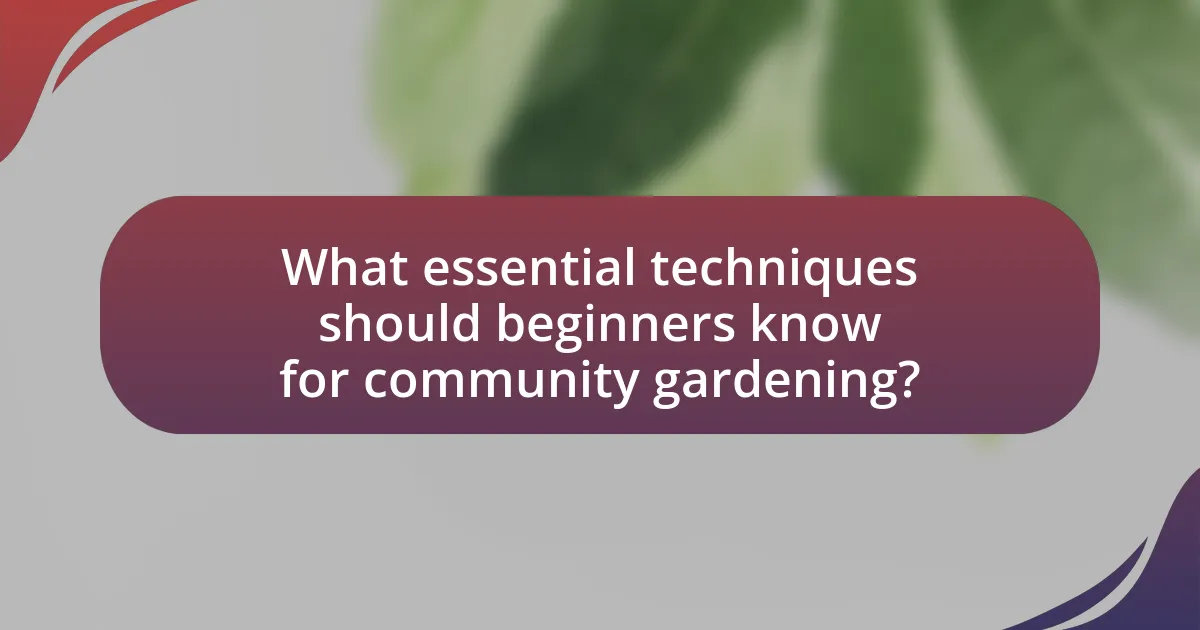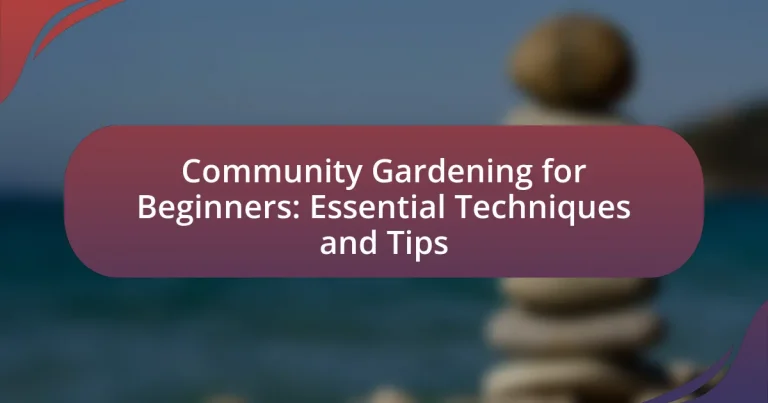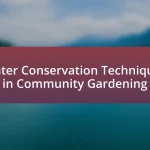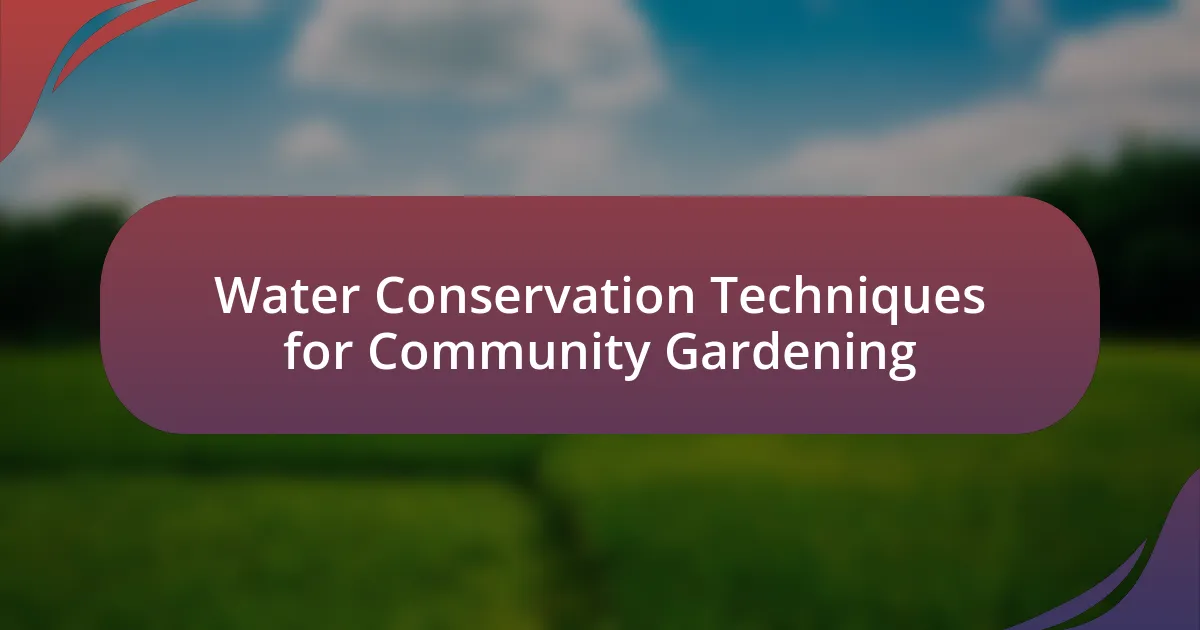Community gardening is a collaborative effort where individuals cultivate shared plots of land, promoting community engagement, sustainable food production, and biodiversity. This article outlines the differences between community gardening and traditional gardening, emphasizing the communal aspect that fosters social interaction and environmental sustainability. Key characteristics of community gardens, their importance in urban areas, and the numerous benefits they provide, such as improved access to fresh produce and enhanced mental health, are discussed. Additionally, essential techniques for beginners, including soil preparation, plant selection, and effective watering methods, are highlighted, along with strategies for overcoming common challenges like pest management and water supply issues. Resources available for community gardeners and best practices for maintaining a thriving garden are also covered, providing a comprehensive guide for those interested in starting their community gardening journey.

What is Community Gardening?
Community gardening is a collaborative gardening effort where individuals come together to cultivate a shared plot of land. This practice fosters community engagement, promotes sustainable food production, and enhances local biodiversity. According to the American Community Gardening Association, community gardens can improve access to fresh produce, strengthen community ties, and provide educational opportunities about gardening and nutrition.
How does community gardening differ from traditional gardening?
Community gardening differs from traditional gardening primarily in its collaborative nature, where multiple individuals or families share a garden space to grow plants collectively. In community gardening, participants often work together to cultivate the land, share resources, and distribute the harvest, fostering a sense of community and social interaction. Traditional gardening typically involves individual ownership and management of a private garden, where one person or family is solely responsible for the cultivation and maintenance of their plants. This distinction highlights the communal aspect of community gardening, which can enhance social ties and promote sustainable practices among diverse groups.
What are the key characteristics of community gardens?
Community gardens are characterized by shared spaces where individuals cultivate plants collectively. These gardens typically feature diverse plant species, including vegetables, fruits, and flowers, promoting biodiversity. They are often organized and maintained by local community members, fostering social interaction and collaboration. Community gardens also emphasize sustainability practices, such as organic gardening and composting, which contribute to environmental health. Additionally, they serve educational purposes, providing opportunities for learning about gardening, nutrition, and environmental stewardship. Research indicates that community gardens can enhance community cohesion and improve access to fresh produce, thereby supporting public health initiatives.
Why is community gardening important for urban areas?
Community gardening is important for urban areas because it enhances food security, promotes social interaction, and improves environmental sustainability. Urban areas often face challenges such as limited access to fresh produce and green spaces; community gardens address these issues by providing local, healthy food options. According to a study published in the Journal of Community Health, community gardens can increase access to fruits and vegetables by up to 40% for nearby residents. Additionally, these gardens foster community cohesion by bringing together diverse groups of people, which can lead to stronger social networks and reduced crime rates. Furthermore, community gardens contribute to urban biodiversity and help mitigate the urban heat island effect, making cities more resilient to climate change.
What are the benefits of community gardening?
Community gardening offers numerous benefits, including enhanced social interaction, improved mental health, and increased access to fresh produce. These gardens foster community engagement by bringing people together, which can lead to stronger neighborhood ties and a sense of belonging. Research indicates that participation in community gardening can reduce stress and anxiety, contributing to better mental well-being. Additionally, community gardens provide a sustainable source of fresh fruits and vegetables, promoting healthier eating habits and food security. According to a study published in the Journal of Community Health, community gardens can increase fruit and vegetable consumption among participants by up to 50%.
How does community gardening promote social interaction?
Community gardening promotes social interaction by creating a shared space where individuals collaborate on gardening tasks, fostering relationships and community bonds. This collaborative environment encourages communication and teamwork, as participants often share gardening tips, resources, and experiences. Research indicates that community gardens can enhance social ties; for instance, a study published in the Journal of Community Psychology found that participants reported increased feelings of belonging and social support after engaging in community gardening activities.
What environmental benefits does community gardening provide?
Community gardening provides significant environmental benefits, including improved air quality, enhanced biodiversity, and effective stormwater management. By cultivating plants, community gardens absorb carbon dioxide and release oxygen, contributing to cleaner air. Additionally, these gardens create habitats for various species, promoting biodiversity in urban areas. Furthermore, community gardens help manage stormwater runoff by allowing rainwater to infiltrate the soil, reducing flooding and erosion. Studies have shown that urban green spaces, such as community gardens, can lower surface temperatures and mitigate the urban heat island effect, further supporting environmental health.

What essential techniques should beginners know for community gardening?
Beginners in community gardening should know essential techniques such as soil preparation, plant selection, and effective watering methods. Soil preparation involves testing pH levels and amending the soil with organic matter to enhance fertility, which is crucial for healthy plant growth. Selecting plants that are suitable for the local climate and soil conditions increases the chances of successful cultivation; for instance, native plants often require less maintenance and are more resilient. Effective watering techniques, including drip irrigation or soaker hoses, help conserve water and ensure that plants receive adequate moisture without overwatering, which can lead to root rot. These techniques are foundational for establishing a thriving community garden.
How do you choose the right location for a community garden?
To choose the right location for a community garden, assess factors such as sunlight, soil quality, water access, and community accessibility. Sunlight is crucial; a site should receive at least six hours of direct sunlight daily to support plant growth. Soil quality must be tested for contaminants and nutrient levels, as healthy soil promotes robust plant development. Access to water is essential for irrigation; proximity to a water source can significantly ease maintenance. Additionally, the location should be easily accessible to community members to encourage participation and engagement. Research indicates that gardens located in areas with high foot traffic and community visibility tend to attract more participants and foster a sense of ownership among locals.
What factors should be considered when selecting a site?
When selecting a site for community gardening, key factors include sunlight exposure, soil quality, water access, and proximity to community members. Sunlight exposure is crucial as most vegetables require at least six hours of direct sunlight daily for optimal growth. Soil quality must be assessed for nutrients and drainage; testing kits can determine pH and nutrient levels, ensuring the soil supports plant health. Water access is essential for irrigation; sites should have a reliable water source or be near a water supply. Proximity to community members enhances participation and maintenance, fostering a sense of ownership and collaboration among gardeners. These factors collectively contribute to the success of a community garden.
How does sunlight exposure affect plant growth in community gardens?
Sunlight exposure significantly enhances plant growth in community gardens by providing the necessary energy for photosynthesis. Plants require adequate sunlight to convert carbon dioxide and water into glucose and oxygen, which are essential for their growth and development. Research indicates that most vegetables and flowering plants thrive with at least six hours of direct sunlight daily, as noted in studies by the University of California Cooperative Extension, which emphasize that insufficient sunlight can lead to stunted growth and reduced yields. Therefore, optimizing sunlight exposure is crucial for maximizing the productivity of community gardens.
What are the best practices for soil preparation?
The best practices for soil preparation include testing soil pH and nutrient levels, amending soil with organic matter, tilling to aerate, and ensuring proper drainage. Testing soil allows gardeners to understand its composition and deficiencies, which is crucial for effective amendments. Adding organic matter, such as compost, improves soil structure and fertility, enhancing plant growth. Tilling the soil helps to break up compacted layers, promoting root development and water infiltration. Lastly, ensuring proper drainage prevents waterlogging, which can harm plant roots. These practices collectively create a healthy growing environment for plants in community gardens.
How do you test soil quality for gardening?
To test soil quality for gardening, you can conduct a soil test using a soil testing kit or by sending a sample to a laboratory. A soil testing kit typically measures pH, nutrient levels, and organic matter content, providing essential information for optimal plant growth. For instance, a pH level between 6.0 and 7.0 is generally ideal for most garden plants, while nutrient levels such as nitrogen, phosphorus, and potassium are crucial for healthy development. Soil testing laboratories often provide detailed analyses and recommendations based on the specific needs of your garden, ensuring that you can amend the soil effectively for better gardening outcomes.
What amendments can improve soil health?
Organic matter, such as compost, can significantly improve soil health by enhancing its structure, nutrient content, and moisture retention. Compost adds essential nutrients and beneficial microorganisms, which promote plant growth and soil biodiversity. Additionally, the incorporation of cover crops, like clover or rye, can prevent soil erosion, suppress weeds, and improve soil fertility through nitrogen fixation. Research indicates that soils enriched with organic amendments can increase microbial activity and improve overall soil health, leading to better crop yields and resilience against pests and diseases.

What tips can help beginners succeed in community gardening?
To succeed in community gardening, beginners should start by selecting a suitable location with adequate sunlight and access to water. Research indicates that plants typically require at least six hours of sunlight daily for optimal growth, making site selection crucial. Additionally, beginners should engage with fellow gardeners to share knowledge and resources, as collaboration fosters a supportive environment and enhances learning. According to a study published in the Journal of Community Gardening, community engagement significantly increases the likelihood of gardening success by providing emotional support and practical advice. Lastly, beginners should familiarize themselves with local soil conditions and consider soil testing to ensure proper nutrient levels, as healthy soil is foundational for plant health and productivity.
How can beginners effectively plan their garden layout?
Beginners can effectively plan their garden layout by first assessing the available space and sunlight exposure. This involves measuring the area, noting any existing structures, and determining how much sunlight different parts of the garden receive throughout the day. Research indicates that most vegetables require at least six hours of sunlight daily for optimal growth.
Next, beginners should sketch a layout that includes pathways for easy access and considers the mature size of plants to avoid overcrowding. Companion planting can also be utilized to enhance growth and deter pests, as certain plants benefit from being grown together.
Finally, utilizing resources such as local gardening guides or community gardening workshops can provide tailored advice and proven strategies for specific climates and soil types, ensuring a successful garden layout.
What are the best planting techniques for beginners?
The best planting techniques for beginners include starting with seeds indoors, using seed trays for better germination, and transplanting seedlings outdoors after the last frost. These methods allow for better control over growing conditions and increase the chances of successful plant establishment. Research indicates that starting seeds indoors can lead to earlier harvests and healthier plants, as it provides a controlled environment that protects young plants from adverse weather conditions. Additionally, using quality soil and ensuring proper spacing between plants are crucial for optimal growth and yield.
How can companion planting enhance garden productivity?
Companion planting enhances garden productivity by optimizing plant relationships to improve growth, yield, and pest resistance. For instance, planting tomatoes alongside basil can increase tomato growth and flavor while repelling pests. Research indicates that certain plant combinations can lead to increased nutrient uptake and better pollination, which directly contributes to higher yields. Additionally, companion planting can reduce the need for chemical pesticides, promoting a healthier ecosystem in the garden.
What common challenges do community gardeners face?
Community gardeners commonly face challenges such as limited access to land, inconsistent water supply, and pest management issues. Limited access to land often results from high demand for gardening space in urban areas, making it difficult for gardeners to secure plots. Inconsistent water supply can hinder plant growth, especially during dry seasons, as community gardens may rely on shared resources. Additionally, pest management issues arise due to the communal nature of gardening, where pests can quickly spread among plots, complicating efforts to maintain healthy plants. These challenges are documented in various studies, including research from the American Community Gardening Association, which highlights the need for effective resource management and community cooperation to overcome these obstacles.
How can pests and diseases be managed in community gardens?
Pests and diseases in community gardens can be managed through integrated pest management (IPM) strategies. IPM involves monitoring pest populations, using cultural practices such as crop rotation and companion planting, and applying biological controls like beneficial insects. Research indicates that implementing these methods can reduce pesticide use by up to 50%, promoting a healthier ecosystem. Additionally, regular inspections and maintaining plant health through proper watering and fertilization can prevent disease outbreaks. These practices collectively enhance the resilience of community gardens against pests and diseases.
What strategies can help with water management in gardens?
Effective water management in gardens can be achieved through strategies such as implementing drip irrigation systems, utilizing mulch, and selecting drought-resistant plants. Drip irrigation delivers water directly to the plant roots, minimizing evaporation and runoff, which can lead to water savings of up to 50% compared to traditional watering methods. Mulching helps retain soil moisture, reduces weed growth, and regulates soil temperature, contributing to overall water efficiency. Additionally, choosing drought-resistant plants can significantly reduce water needs, as these plants are adapted to thrive in low-water conditions, further enhancing water conservation efforts in community gardens.
What resources are available for community gardeners?
Community gardeners have access to a variety of resources, including local gardening clubs, extension services, and online platforms. Local gardening clubs often provide workshops, networking opportunities, and shared knowledge among members. Extension services, offered by universities, supply research-based information on plant care, pest management, and soil health. Online platforms, such as gardening forums and social media groups, facilitate the exchange of tips, resources, and support among community gardeners. These resources collectively enhance the gardening experience and promote successful community gardening initiatives.
How can local gardening clubs and organizations support beginners?
Local gardening clubs and organizations can support beginners by providing educational resources, hands-on workshops, and mentorship opportunities. These clubs often organize events that teach essential gardening techniques, such as soil preparation, planting, and pest management, which are crucial for novice gardeners. For instance, a study by the American Community Gardening Association found that community gardening programs significantly enhance gardening skills and knowledge among participants. Additionally, clubs frequently connect beginners with experienced gardeners who can offer personalized guidance and support, fostering a collaborative learning environment.
What online resources provide valuable information for community gardening?
Online resources that provide valuable information for community gardening include the American Community Gardening Association (ACGA), which offers guides, best practices, and networking opportunities for community gardeners. Additionally, the website Gardening Know How provides practical advice on various gardening techniques and troubleshooting common issues. The USDA’s Community Food Projects program also offers resources and funding opportunities for community gardening initiatives. These platforms collectively support community gardeners by providing essential information, resources, and community connections.
What are the best practices for maintaining a thriving community garden?
The best practices for maintaining a thriving community garden include regular maintenance, effective communication among members, and sustainable gardening techniques. Regular maintenance involves tasks such as weeding, watering, and harvesting, which should be scheduled consistently to ensure plant health and productivity. Effective communication among community members fosters collaboration, allowing for shared responsibilities and problem-solving, which is essential for addressing issues like pest control or resource allocation. Sustainable gardening techniques, such as composting and crop rotation, enhance soil health and biodiversity, contributing to a more resilient garden ecosystem. Research indicates that community gardens can improve local food security and promote social cohesion, highlighting the importance of these practices in achieving a successful garden.





